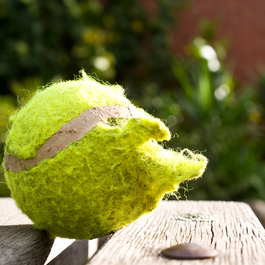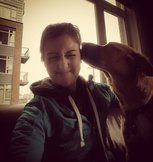
What started out as a game, somewhere along the line, has become serious.
“Throw it! You are supposed to throw it!” He’s panting and foaming at the mouth, his body coiled like a spring. He looks at you, then the ball, then at you, then the ball. You toss his favorite toy into the air and he leaps, with a slapping sound he snatches it from the air. An instant later it is at your feet. He looks at you, then the ball, then at you, then the ball… After 45 repetitions, he looks exhausted, but the intensity of his ping-pong gaze begs otherwise.
Where is the line between intense play and obsessive behavior? The reward system in a dog’s brain is similar to that in humans. Dogs can become literally addicted to certain activities much like humans do, often engaging in a behavior long after it have become pleasurable to do so.
“Throw it! You are supposed to throw it!” He’s panting and foaming at the mouth, his body coiled like a spring. He looks at you, then the ball, then at you, then the ball. You toss his favorite toy into the air and he leaps, with a slapping sound he snatches it from the air. An instant later it is at your feet. He looks at you, then the ball, then at you, then the ball… After 45 repetitions, he looks exhausted, but the intensity of his ping-pong gaze begs otherwise.
Where is the line between intense play and obsessive behavior? The reward system in a dog’s brain is similar to that in humans. Dogs can become literally addicted to certain activities much like humans do, often engaging in a behavior long after it have become pleasurable to do so.
Here are some warning signs that your dog may be an ball junkie.
- Persistence: If you give clear communication to your dog that playtime is over and he continues to drop the ball at your feet again and again and again or whines or barks incessantly, this is a warning sign.
- Stiff Posture: When dogs are in play mode, their bodies are relaxed and their movements are fluid. A stiff posture or tense face may be a sign that your dog is fixated. Some dogs will exhibit tremors, often in the haunches or the lower jaw when they’re really jonesing.
- Guarding: Showing teeth, growling, or snapping in response to another dog (or human) taking control of their favorite toy shows that play has stopped and the game has become serious.
- Tunnel Vision: A fixated dog only sees the object of fixation. He will not notice the truck going by, or the bird overhead, or the dog next to him attempting to initiate play. He may not notice a sprained leg, a cut pad, or bleeding gums. Some addicted dogs can play to exhaustion or even heat stroke.

What not to do?
- Do not ignore the behavior. Without attention, the problem will not get better and can escalate. And remember, it isn’t fun for your dog but acutely stressful.
- Do not engage your dog in obsessive behavior with the hope that he will eventually tire of it. This is unlikely to happen and may put your dog’s health at risk.
- Do not punish the behavior. Punishment increases stress which often strengthens anxiety making negative behavior more likely.
- Do not give in to your dog. Once you have made the decision that play is over, stick to it, even when confronted with those longing baby browns. When they whine or bark, be firm but gentle. It’s for their own good.

What to do?
Final Note: Each dog’s personality is different, know your dog and consult a certified trainer for advice. I hope these tips have been helpful.
- Give your dog plenty of exercise and provide him a variety of stimulating activities.
- Mitigate sources of anxiety or frustration in the dogs environment. Often obsessive behaviors can be a fueled by other stressors.
- Stop play if obsessive behavior manifests or play a different game that does not include the valued object.
- Put toys away, out of sight, when playtime is over.
Final Note: Each dog’s personality is different, know your dog and consult a certified trainer for advice. I hope these tips have been helpful.




 RSS Feed
RSS Feed

